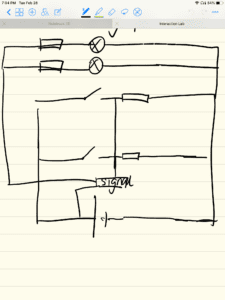The recitation this week focuses on building fading lights, buzzers that sing awfully, and finally the button pressing game that has crazy wires. Specifically, I guess the goal of which is helping us learn the usage of different pins on the Arduino, building complicated circuitry, as well as building our confidence by letting us modify code in an unknown language.
The first circuit was about building a lighting up and fading loop for the LED. In this circuit, we use the PWM to simulate the change in voltage. And it didn’t take us too long before the circuit was built.
However, problems start to arise when we were dealing with the second circuit. In our several trials at the beginning, we weren’t able to have the buzzer singing. At first, we thought the buzzer was broken, but as soon as we switch the wires to the 3.3V, the buzzer was able to make noise again. Eventually, we found that we didn’t move the wire from pin 9 to pin 8, which is responsible for outputting in this circuit. And finally, the buzzer could sing awfully.
The third circuit was a speed game, where we are expected to use the circuit to see which player can hit the button for 10 times quicker. The faster player would have a LED lit up indicating his winning. And this is a very complicated circuit, with different components connected to different pins on the Arduino, different slots on the bread board, things were pretty messy. We could merely do nothing but to follow the schematic. It took us some time before having the circuit working, as we made several mistakes, such as the orientation of the button and the LED. Though we eventually made the circuit working, when the player one wins the match, the corresponding LED couldn’t light up. It wasn’t until the recitation ended that we discovered we used the wrong resistor on the route of the LED.

The final, giant four-player speed game was another mess. After the code was modified and the circuit being rebuilt, we could only dictate the player one and two’s activity, while the clicks of player three and four keep showing 0, and the code was alright after double-checking. Before we turn totally desperate, someone from other groups reached out to us. It turns out we have misconnected some of the pins while assembling the circuit. It started to work after we reassemble the whole circuit.
Answer to question 1:
In my daily life, the technology that I’m having most interaction with is my iPhone, iPad and mac. And in most cases, I interact with them using fingers and eyes. Sometimes, I could use my voice to command Siri on these devices. What’s more, the iPhone has a step counter. In other words, I’m not merely a monster with eyes and fingers only in the eye of my iPhone. A great example of interaction I can think of, is the Kinect by Microsoft. Instead of using a controller, you can use your body to interact with the console, which is much better than iPhone does. In the speed game, we could only have basic interaction happening, which is using our finger to press the button and our eyes to view the result. The interaction being discussed in the text is about having more parts of our body involving in inputting message to the computer, as well as more parts of our body capable of receiving the output from the computer. In such a way, the interaction between users and computers could be more diverse, and let users really focus on what to interact, instead of how to interact.
Answer to question 2:
If I can own 100,000 LEDs, I would like to put them in different arrays, and the arrays are so dense that the resolution is very high. In this way, I can use the LED array as a giant secondary monitor for my laptop.